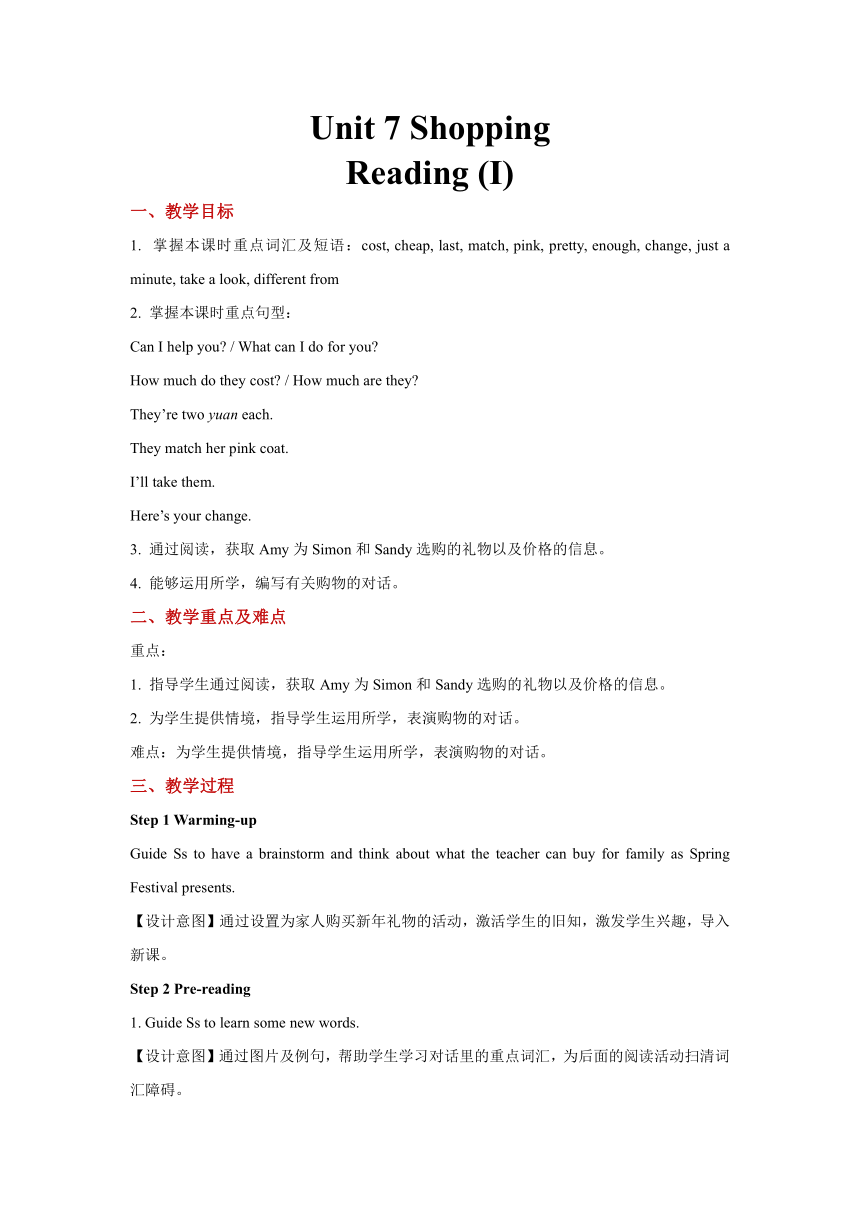译林版七年级英语上册Unit 7 Shopping 第2课时教案
文档属性
| 名称 | 译林版七年级英语上册Unit 7 Shopping 第2课时教案 |  | |
| 格式 | docx | ||
| 文件大小 | 29.8KB | ||
| 资源类型 | 教案 | ||
| 版本资源 | 牛津译林版 | ||
| 科目 | 英语 | ||
| 更新时间 | 2022-10-17 14:40:58 | ||
图片预览

文档简介
Unit 7 Shopping
Reading (Ⅰ)
教学目标
掌握本课时重点词汇及短语:cost, cheap, last, match, pink, pretty, enough, change, just a minute, take a look, different from
2. 掌握本课时重点句型:
Can I help you / What can I do for you
How much do they cost / How much are they
They’re two yuan each.
They match her pink coat.
I’ll take them.
Here’s your change.
3. 通过阅读,获取Amy为Simon和Sandy选购的礼物以及价格的信息。
4. 能够运用所学,编写有关购物的对话。
二、教学重点及难点
重点:
1. 指导学生通过阅读,获取Amy为Simon和Sandy选购的礼物以及价格的信息。
2. 为学生提供情境,指导学生运用所学,表演购物的对话。
难点:为学生提供情境,指导学生运用所学,表演购物的对话。
三、教学过程
Step 1 Warming-up
Guide Ss to have a brainstorm and think about what the teacher can buy for family as Spring Festival presents.
【设计意图】通过设置为家人购买新年礼物的活动,激活学生的旧知,激发学生兴趣,导入新课。
Step 2 Pre-reading
1. Guide Ss to learn some new words.
【设计意图】通过图片及例句,帮助学生学习对话里的重点词汇,为后面的阅读活动扫清词汇障碍。
2. Guide Ss to look at the pictures and try to predict some information.
【设计意图】通过观察课本插图,引导学生预测相关信息,培养学生根据已知内容进行读前预测的能力。
Step 3 While-reading
1. Guide Ss to read and complete the table.
【设计意图】通过阅读两个对话,引导学生检索信息,核对答案之后,引导学生思考礼物是买给谁的。学生大致了解文章基本内容,训练了学生抓住文章主旨的能力。
2. Guide Ss to read and mark T (true) or F (false) in B2.
【设计意图】通过相应的练习,帮助学生对文章进行细节理解。
Step 3 Post-reading
1. Guide Ss to listen, read and act out the dialogue.
【设计意图】通过听,读并表演对话,内化语言和信息。
2. Guide Ss to circle the correct letters, and complete the sentences.
【设计意图】在新的情境中,帮助学生进一步巩固本课的重要词汇及表达。
3. Guide Ss to summarize the expressions frequently used between a customer and a shopkeeper.
【设计意图】带领学生总结售货员与顾客之间的常用语,为后面的口语输出活动做准备。
4. Guide Ss to choose one of the shopping situations and make up a new conversation.
【设计意图】通过设定情境,并引导学生根据情境编写对话,培养学生的语言运用能力。
Step 4 Summary
Summarize what they’ve learnt in this lesson.
Step 5 Homework
1. Recite the two conversations.
2. Make a new conversation about shopping.
【设计意图】朗读背诵帮助学生积累语言知识,通过编写对话,巩固所学。
四、板书设计
Unit 7 Shopping
Reading (Ⅰ)
Shopkeeper:
1. Can I help you
2. What can I do for you
3. Just a minute. Here are some … Take a look.
4. There are many kinds of …
5. They cost …
6. They are … yuan each.
7. What size do you want
8. What/How about …
9. Here is your change.
Customer:
1. I want (to buy) …
2. I’d like …
3. How much do they cost
4. How much are they
5. That’s not cheap.
6. I only have …
7. I’ll take them.
8. I’d like to buy it.
9. I don’t have enough money.
Reading (Ⅰ)
教学目标
掌握本课时重点词汇及短语:cost, cheap, last, match, pink, pretty, enough, change, just a minute, take a look, different from
2. 掌握本课时重点句型:
Can I help you / What can I do for you
How much do they cost / How much are they
They’re two yuan each.
They match her pink coat.
I’ll take them.
Here’s your change.
3. 通过阅读,获取Amy为Simon和Sandy选购的礼物以及价格的信息。
4. 能够运用所学,编写有关购物的对话。
二、教学重点及难点
重点:
1. 指导学生通过阅读,获取Amy为Simon和Sandy选购的礼物以及价格的信息。
2. 为学生提供情境,指导学生运用所学,表演购物的对话。
难点:为学生提供情境,指导学生运用所学,表演购物的对话。
三、教学过程
Step 1 Warming-up
Guide Ss to have a brainstorm and think about what the teacher can buy for family as Spring Festival presents.
【设计意图】通过设置为家人购买新年礼物的活动,激活学生的旧知,激发学生兴趣,导入新课。
Step 2 Pre-reading
1. Guide Ss to learn some new words.
【设计意图】通过图片及例句,帮助学生学习对话里的重点词汇,为后面的阅读活动扫清词汇障碍。
2. Guide Ss to look at the pictures and try to predict some information.
【设计意图】通过观察课本插图,引导学生预测相关信息,培养学生根据已知内容进行读前预测的能力。
Step 3 While-reading
1. Guide Ss to read and complete the table.
【设计意图】通过阅读两个对话,引导学生检索信息,核对答案之后,引导学生思考礼物是买给谁的。学生大致了解文章基本内容,训练了学生抓住文章主旨的能力。
2. Guide Ss to read and mark T (true) or F (false) in B2.
【设计意图】通过相应的练习,帮助学生对文章进行细节理解。
Step 3 Post-reading
1. Guide Ss to listen, read and act out the dialogue.
【设计意图】通过听,读并表演对话,内化语言和信息。
2. Guide Ss to circle the correct letters, and complete the sentences.
【设计意图】在新的情境中,帮助学生进一步巩固本课的重要词汇及表达。
3. Guide Ss to summarize the expressions frequently used between a customer and a shopkeeper.
【设计意图】带领学生总结售货员与顾客之间的常用语,为后面的口语输出活动做准备。
4. Guide Ss to choose one of the shopping situations and make up a new conversation.
【设计意图】通过设定情境,并引导学生根据情境编写对话,培养学生的语言运用能力。
Step 4 Summary
Summarize what they’ve learnt in this lesson.
Step 5 Homework
1. Recite the two conversations.
2. Make a new conversation about shopping.
【设计意图】朗读背诵帮助学生积累语言知识,通过编写对话,巩固所学。
四、板书设计
Unit 7 Shopping
Reading (Ⅰ)
Shopkeeper:
1. Can I help you
2. What can I do for you
3. Just a minute. Here are some … Take a look.
4. There are many kinds of …
5. They cost …
6. They are … yuan each.
7. What size do you want
8. What/How about …
9. Here is your change.
Customer:
1. I want (to buy) …
2. I’d like …
3. How much do they cost
4. How much are they
5. That’s not cheap.
6. I only have …
7. I’ll take them.
8. I’d like to buy it.
9. I don’t have enough money.
同课章节目录
- 预备课程
- Lesson 1 Nice to meet you !
- Lesson 2 A happy family
- Lesson 3 A nice school
- Lesson 4 You look cool !
- Lesson 5 Wonderful things
- Lesson 6 Have nice food
- Lesson 7 Enjoy our days
- Lesson 8 Let's have fun !
- Unit 1 This is me
- Unit 2 Let's play sports
- Unit 3 Welcome to our school
- Unit 4 My day
- Unit 5 Let’s celebrate
- Unit 6 Food and lifestyle
- Unit 7 Shopping
- Unit 8 Fashion
